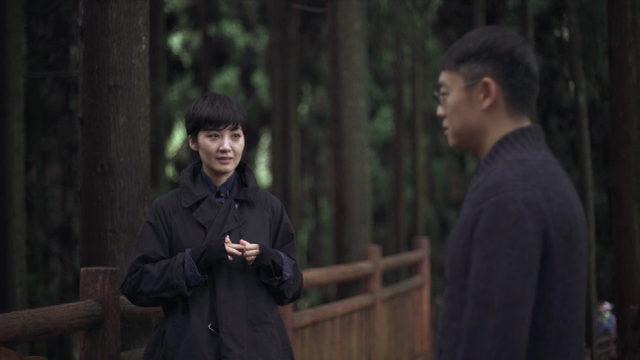中文 5x30' 高清,2022
Chinese 5x30' HD, 2022
智慧東方
智慧東方
Wisdom from the East
節目介紹 / Introduction
儒家的仁義禮智,道家的清靜無為,釋家的悲智行願,構成了中國人的文化基因。然而在歷史的顯隱之間,中國人遭遇了文化斷裂,陷入了道德困境。西方科技發達為人類帶來文明,同時亦帶來精神上的污染。從南國到北疆,我們探訪普羅大眾的信仰世界,桃源問津;從峨眉到九華,我們尋訪高僧大德的靈修故事。《智慧東方》分享他們的佛教修行感悟,為你的人生問題指點迷津。
五臺山 30’
在中國的四大佛教名山中,只有五臺山是有多位皇帝親自來過的。歷朝歷代的帝王們,在五臺山建寺塔,大興皇家道場。五臺山一路發展下來,最終形成了漢藏共存、青黃並存的獨特人文景象。在這裡,無論漢藏,無論顯密,都可以化到合適的朝禮和修行道場。
天臺山 國清寺 30’
中國有四座被世人所公認的佛教名山,分別是五台,峨眉,九華和普陀,但在英國人李提摩太的心中,卻還有另一座佛教名山,而且它的地位甚至高於其他四座山頭。清朝時期,曾在華傳教45年的李提摩太,在他的回憶錄——《親歷晚清十年》中寫道:天臺山是與耶路撒冷,麥加等宗教聖地相提並論的東方宗教中心…
百丈禪寺 30’
唐代禪宗巨匠懷海在百丈禪寺住持禪法二十年,撰修百丈清規而聲名大振,引來無數禪學之人,曾出現“三寺五廟四十八庵”之盛況。“百丈清規”的制定,推動了佛教職工禪宗的發展與興盛,奠定了百丈寺禪宗祖庭的地位,歷代皇帝對百丈寺都有敕封或敕建,這一切使百丈寺在中外佛教界享有盛名。
西雙版納向佛記 30’
南傳上座部佛教大約於西元七世紀,傳入中國雲南西雙版納地區。在千百年的傳承中,逐漸成為傣族等少數民族的全民信仰。然而在文革時期,傣族的佛教信仰遭遇嚴重衝擊。一個民族的信仰體系如何復蘇?佛學院的創辦能否解決僧才越來越少的問題?
我們為什麼不快樂 30’
這個世界上的多數人在多數時候,都在不快樂和快樂中頻繁搖擺。但在深圳弘法寺,有一群人從劍法中找到逐漸穩定的快樂。現為珠寶和茶葉商人的林瓊麗,曾經是一家大型國企的副總。在外人眼裡名利雙收的她,貌似一切都有,但除了快樂。直到有一天,一個契機令她重新思考活著的意義。
香港佛光道 30’
現今社會,女性的社會地位已經有了很大的提高。那麼,佛教是如何看待女性的?而無論出家還是在家修行的女性又將如可突破傳統與現實的桎梏,在佛界與俗界綻放如的芬芳?智慧東方走訪大陸和香港兩地的女眾道場,探訪其中的特色與亮點。
寒山寺的鐘聲詩韻 30’
寒山寺,一個不大的寺院,它既不是佛教宗派的祖庭,但僅僅因為一首詩,便令它名揚四海。寒山寺的鐘聲,中國人熟悉,因為它穿越了華夏1500多年的時空;這鐘聲,外國人也熟悉,因為那首《楓橋夜泊》的詩歌把它帶出了國門。詩以寺傳,寺以詩名,鐘聲詩韻,延綿千年。
五臺山 30’
在中國的四大佛教名山中,只有五臺山是有多位皇帝親自來過的。歷朝歷代的帝王們,在五臺山建寺塔,大興皇家道場。五臺山一路發展下來,最終形成了漢藏共存、青黃並存的獨特人文景象。在這裡,無論漢藏,無論顯密,都可以化到合適的朝禮和修行道場。
天臺山 國清寺 30’
中國有四座被世人所公認的佛教名山,分別是五台,峨眉,九華和普陀,但在英國人李提摩太的心中,卻還有另一座佛教名山,而且它的地位甚至高於其他四座山頭。清朝時期,曾在華傳教45年的李提摩太,在他的回憶錄——《親歷晚清十年》中寫道:天臺山是與耶路撒冷,麥加等宗教聖地相提並論的東方宗教中心…
百丈禪寺 30’
唐代禪宗巨匠懷海在百丈禪寺住持禪法二十年,撰修百丈清規而聲名大振,引來無數禪學之人,曾出現“三寺五廟四十八庵”之盛況。“百丈清規”的制定,推動了佛教職工禪宗的發展與興盛,奠定了百丈寺禪宗祖庭的地位,歷代皇帝對百丈寺都有敕封或敕建,這一切使百丈寺在中外佛教界享有盛名。
西雙版納向佛記 30’
南傳上座部佛教大約於西元七世紀,傳入中國雲南西雙版納地區。在千百年的傳承中,逐漸成為傣族等少數民族的全民信仰。然而在文革時期,傣族的佛教信仰遭遇嚴重衝擊。一個民族的信仰體系如何復蘇?佛學院的創辦能否解決僧才越來越少的問題?
我們為什麼不快樂 30’
這個世界上的多數人在多數時候,都在不快樂和快樂中頻繁搖擺。但在深圳弘法寺,有一群人從劍法中找到逐漸穩定的快樂。現為珠寶和茶葉商人的林瓊麗,曾經是一家大型國企的副總。在外人眼裡名利雙收的她,貌似一切都有,但除了快樂。直到有一天,一個契機令她重新思考活著的意義。
香港佛光道 30’
現今社會,女性的社會地位已經有了很大的提高。那麼,佛教是如何看待女性的?而無論出家還是在家修行的女性又將如可突破傳統與現實的桎梏,在佛界與俗界綻放如的芬芳?智慧東方走訪大陸和香港兩地的女眾道場,探訪其中的特色與亮點。
寒山寺的鐘聲詩韻 30’
寒山寺,一個不大的寺院,它既不是佛教宗派的祖庭,但僅僅因為一首詩,便令它名揚四海。寒山寺的鐘聲,中國人熟悉,因為它穿越了華夏1500多年的時空;這鐘聲,外國人也熟悉,因為那首《楓橋夜泊》的詩歌把它帶出了國門。詩以寺傳,寺以詩名,鐘聲詩韻,延綿千年。
Confucianism, Taoism and Buddhism are the foundation of the Chinese culture. However, the changing of history and western technology advancement have given a big shock to Chinese culture and put us in the moral predicament. We visited to different eminent monks who shared their stories of devotion so as to find a guidance of life in these Chinese philosophical thinking.
Mount Wutai (30’)
Among the four main famous sacred Buddhist mountains in China, Mount Wutai is the only mountain which many emperors had gone there personally. Emperors of past dynasties built pagodas on Mount Wutai, resulting in many royal monasteries. As Mount Wutai develops, it eventually becomes a unique cultural sight where the Han Buddhism and Tibetan Buddhism co-exist and many different monasteries are present. At this place, be it the Chinese or Tibetans; be it exoteric Buddhism or esoteric Buddhism, all can find suitable pilgrimages and places for spiritual practice.
Mount Tiantai and Guoqing Temple (30’)
There are four famous and recognised sacred Buddhist mountains in China, which are Wutai, Emei, Jiuhua and Putuo. However, to the Englishman, Timothy Richard, there is another famous Buddhist mountain and it holds a higher status than the other four mountains. During the Qing Dynasty, Timothy Richard was a missionary in China for 45 years. In his memoirs, "Ten years of experiences in the late Qing Dynasty", this was written. "Mount Tiantai is a religious centre in the East that is on par with holy lands like Jerusalem and Mecca..."
Baizhang Temple (30’)
Zen master during the Tang Dynasty, Huai Hai, meditated in Baizhang Temple for two decades. He wrote and revised the monastic rules of Baizhang and gained considerable reputation. That attracted countless people who were interested in learning the way of Zen, thus creating a sensation. The formulation of "Monastic rules of Baizhang" promotes the development and rise of Zen Buddhism, establishing the founder status of Baizhang Temple in Zen Buddhism. Emperors of past dynasties had conferred titles or ordered the construction of Baizhang Temple. These make Baizhang Temple renowned to the Buddhist community in China and abroad.
Buddhism in Xishuangbanna Region (30’)
Theravada Buddhism was introduced into Xishuangbanna region in Yunnan of China at around the seventh century. In its thousands of years of heritage, it gradually becomes the religion of the minority ethnic groups such as the Dai people. However, during the Cultural Revolution, the Dai people's faith in religion was sorely tested. How does an ethnic group restore their faith in their religion? Can the establishment of Buddhist colleges solve the problem of diminishing number of monks?
Why Are We Unhappy? (30’)
In this world, most people swing between happiness and unhappiness frequently at most of the times. However, inside Hongfa Temple in Shenzhen, there is a group of people who gradually finds stable happiness in sword skills. Lin Qiongli, who is now a jewellery dealer and tea merchant, was once the vice president of a large state-owned enterprise. To the outside world, it seems that she has wealth and fame. She has everything, except happiness. It was until one day when something happened that she started reconsidering the meaning of life.
Temples in Hong Kong (30’)
In today's society, women's status has been greatly elevated. How does Buddhism view women? How do nuns or women who are practising Buddhism at home break free from the shackles of tradition and reality to exude brilliance in the Buddhist community and the secular world? Wisdom from the East visits the nunneries in China and Hong Kong to find out their features and highlights.
The Bells and Poem of Hanshan Temple (30’)
Hanshan Temple is a small temple. It isn't the birthplace of Buddhism, but it becomes well-known because of a mere poem. The Chinese are familiar with the bells of Hanshan Temple because they have traversed Chinese civilization for more than 1500 years. Foreigners are familiar with the bells as well because the poem, "A Night Mooring by Maple Bridge", makes it well-known. Hanshan Temple and the poem complement each other. The bells and poem of Hanshan stretch beyond thousands of years.
Mount Wutai (30’)
Among the four main famous sacred Buddhist mountains in China, Mount Wutai is the only mountain which many emperors had gone there personally. Emperors of past dynasties built pagodas on Mount Wutai, resulting in many royal monasteries. As Mount Wutai develops, it eventually becomes a unique cultural sight where the Han Buddhism and Tibetan Buddhism co-exist and many different monasteries are present. At this place, be it the Chinese or Tibetans; be it exoteric Buddhism or esoteric Buddhism, all can find suitable pilgrimages and places for spiritual practice.
Mount Tiantai and Guoqing Temple (30’)
There are four famous and recognised sacred Buddhist mountains in China, which are Wutai, Emei, Jiuhua and Putuo. However, to the Englishman, Timothy Richard, there is another famous Buddhist mountain and it holds a higher status than the other four mountains. During the Qing Dynasty, Timothy Richard was a missionary in China for 45 years. In his memoirs, "Ten years of experiences in the late Qing Dynasty", this was written. "Mount Tiantai is a religious centre in the East that is on par with holy lands like Jerusalem and Mecca..."
Baizhang Temple (30’)
Zen master during the Tang Dynasty, Huai Hai, meditated in Baizhang Temple for two decades. He wrote and revised the monastic rules of Baizhang and gained considerable reputation. That attracted countless people who were interested in learning the way of Zen, thus creating a sensation. The formulation of "Monastic rules of Baizhang" promotes the development and rise of Zen Buddhism, establishing the founder status of Baizhang Temple in Zen Buddhism. Emperors of past dynasties had conferred titles or ordered the construction of Baizhang Temple. These make Baizhang Temple renowned to the Buddhist community in China and abroad.
Buddhism in Xishuangbanna Region (30’)
Theravada Buddhism was introduced into Xishuangbanna region in Yunnan of China at around the seventh century. In its thousands of years of heritage, it gradually becomes the religion of the minority ethnic groups such as the Dai people. However, during the Cultural Revolution, the Dai people's faith in religion was sorely tested. How does an ethnic group restore their faith in their religion? Can the establishment of Buddhist colleges solve the problem of diminishing number of monks?
Why Are We Unhappy? (30’)
In this world, most people swing between happiness and unhappiness frequently at most of the times. However, inside Hongfa Temple in Shenzhen, there is a group of people who gradually finds stable happiness in sword skills. Lin Qiongli, who is now a jewellery dealer and tea merchant, was once the vice president of a large state-owned enterprise. To the outside world, it seems that she has wealth and fame. She has everything, except happiness. It was until one day when something happened that she started reconsidering the meaning of life.
Temples in Hong Kong (30’)
In today's society, women's status has been greatly elevated. How does Buddhism view women? How do nuns or women who are practising Buddhism at home break free from the shackles of tradition and reality to exude brilliance in the Buddhist community and the secular world? Wisdom from the East visits the nunneries in China and Hong Kong to find out their features and highlights.
The Bells and Poem of Hanshan Temple (30’)
Hanshan Temple is a small temple. It isn't the birthplace of Buddhism, but it becomes well-known because of a mere poem. The Chinese are familiar with the bells of Hanshan Temple because they have traversed Chinese civilization for more than 1500 years. Foreigners are familiar with the bells as well because the poem, "A Night Mooring by Maple Bridge", makes it well-known. Hanshan Temple and the poem complement each other. The bells and poem of Hanshan stretch beyond thousands of years.




